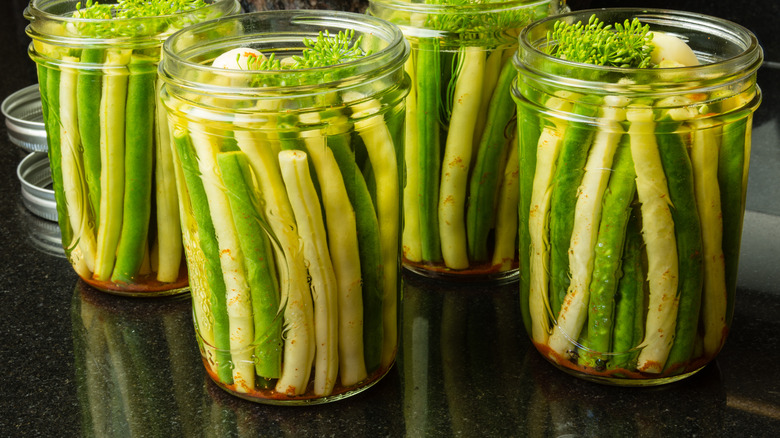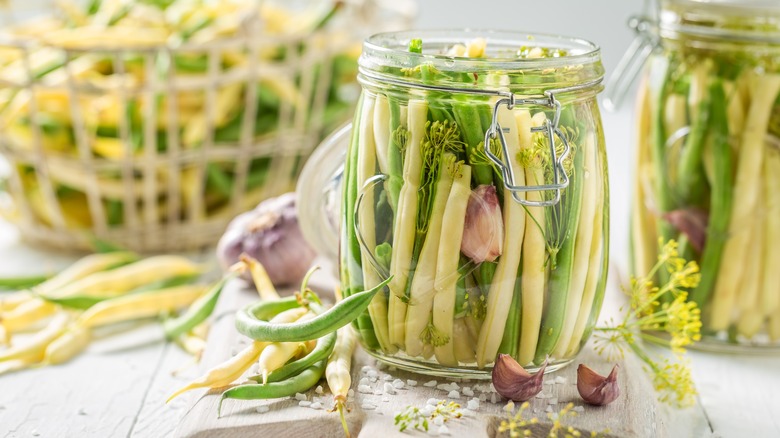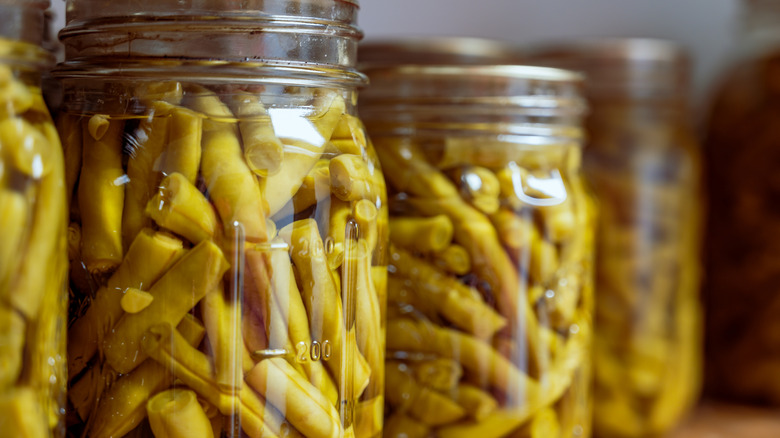How To Make Home-Canned Green Beans Without A Pressure Canner
Canning your own vegetables has become increasingly popular, but it's important to know the difference between the various methods. Water bathing and pressure canning are common, but each has optimal uses. For vegetables like green beans that are low in acid and more susceptible to bacteria growth, the USDA recommends pressure canning as it's the safest way to ensure you don't develop a foodborne illness like botulism. Per the Centers for Disease Control and Prevention, botulism is a toxin that attacks a person's nervous system and can even cause death. Unfortunately, it can be found in improperly canned foods, which is why foods with low acidity need to be cooked at a temperature greater than boiling water.
Although one way to attain this is with a pressure canner, there's a safe way to home-can green beans without using the appliance: pickling. Pressure canners can cost hundreds of dollars, so if you want to can low-acid vegetables like green beans without making the investment, then you should try pickling. This will help raise the acidity, allowing you to use the water bath method instead.
Pickling green beans
When pickling green beans, you should first choose the appropriate kind of bean. Generally speaking, the thicker the green beans, the better they will pickle. Sorry French-style bean fans, but the thin beans aren't a good choice for this process. Likewise, you'll want to make sure that all of your beans are of a similar size so that they pickle evenly. If you want a crisper result then consider blanching before pickling. Blanching is the process of heating the green beans in boiling water and then rapidly cooling them down in an ice bath. A quick dip in the hot water is sufficient; since you're pickling the beans, the last thing you want is for them to end up mushy or soggy.
The other important aspect to consider is creating the perfect pickling brine. Most brines consist of only four ingredients: water, white vinegar, salt, and sugar. You should use a ratio of one to one of water to vinegar. The vinegar will raise the acid level of the green beans, which should help prevent any bacteria in storage. Sugar and salt can kill bacteria and prolong the shelf-life as well. Making the brine is as simple as mixing the ingredients and boiling them on the stove.
Tips for canning green beans
When it comes to canning green beans, start by water-bathing your jars as you would with other pickled vegetables or highly acidic fruit. If your green beans are too long, then trim them down to an appropriate size. When adding them to the jar, avoid packing it too full as you will need space to pour in the brine. Additionally, leave about half an inch of space at the top of your jar and remove any air bubbles from the brine.
When canning via boiling water, be sure to use a pot that is big enough to allow your jar to be fully submerged. This will help ensure that the jar is properly sealed. You should also avoid laying the jars on their sides in the pot to prevent an improper seal. After the canning process, double-check that your seal is properly set. Give the jar of green beans around a day to properly cool. From there, gently press your finger into the center of the jar to make sure the lid doesn't move. Pickled green beans have a sour taste compared with regular green beans, making them a pleasantly tangy snack to munch on.


